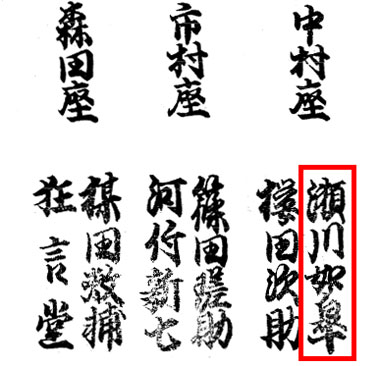| SEGAWA JOKď III |
|
Pen names:
Poetry name: Tobun Existence: 1806 ~ 28 June 1881 Connection: Master: Tsuruya Nanboku V Disciples: Hama Hikosuke, Fujimoto Motosuke In-law: Segawa Jok˘ IV Career: 1806: born in Edo. His name is Rokur˘. He keeps a gofukuya (drapery shop) in Edo. 5th lunar month of 1839: he becomes sakusha and works at the Kawarasakiza. His two first pen names are Shibori Kichihei and Shibori Kichibŕ. 11th lunar month of 1843: he becomes disciple of Tsuruya Nanboku V and receives the name of Uba J˘suke III [2]; he works, along with the tatesakusha Kawatake Shinshichi II, at the Kawarasakiza on the drama "Osana Gunp˘ Jűroku Musashi", which celebrates the shűmei of Arashi Koroku V. others main actors are Band˘ Hikosabur˘ IV, Seki Sanjűr˘ III, Nakamura Utaemon IV, Onoe Eizabur˘ III, Segawa Kikusabur˘ III and Nakamura Shibajűr˘. 1845: he takes the name of Fujimoto Kichibŕ. 11th lunar month of 1845: Kichibŕ works at the Ichimuraza, along with Sakurada Jisuke III (tatesakusha), Fukumori Kyűji and Shimizu Sh˘shichi II, on the drama "Kaikei Shinoda Mitsuki no Funauta". 11th lunar month of 1848: he becomes tatesakusha and works at the Nakamuraza on the drama "Kin no Zai Ch˘ja no Yumitori", which celebrates the shűmei of Sawamura Ch˘jűr˘ V. Kichibŕ is assisted by the sakusha Ichioka Wasuke, Teshima Shinz˘ and Umemori Harusuke. 9th lunar month of 1850: premiere at the Nakamuraza of the drama "Minoriyoshi Kogane no Kikuzuki", a revision by Kichibŕ of the ghost play "Banshű Sarayashiki" [more details]. 11th lunar month of 1850: he takes the name of Segawa Jok˘ III, working at the Nakamuraza on the drama "Kigoto no Hana Homare no Kisoyama". He also works on the dance-drama "Yuki Furu Hana no Yoshino no Jűi". 4th lunar month of 1851: premiere at the Nakamuraza of Jok˘'s Tokiwazu-based dance "Kioi Jishi Kabuki no Hanakago", commonly called "Kioi Jishi", starring Ichikawa Kodanji IV, Band˘ Takesabur˘ I, Onoe Kikujir˘ II and Iwai Kumesabur˘ III. 8th lunar month of 1851: premiere at the Nakamuraza of Jok˘'s drama "Higashiyama Sakura S˘shi" (commonly called "Sakura Giminden") [casting]. 3rd lunar month of 1853: premiere at the Nakamuraza of Jok˘'s drama "Yowa Nasake Ukina no Yokogushi" (commonly called "Kirare Yosa") [casting]. 5th lunar month of 1856: premiere at the Moritaza of the first version of "Matsuura no Taiko", as 3 extended acts of the classic "Kanadehon Chűshingura". This program, which is written by Ky˘gend˘ Sak˘ II and Jok˘, celebrates the reopening of the Moritaza and is entitled "Shin Butai Iroha no Kakizome". 10th lunar month of 1861: premiere at the Moritaza of Jok˘'s drama "Z˘ho Futatsu Domoe" [casting]. 3rd lunar month of 1870: premiere at the Nakamuraza of "Ume Goyomi Tatsumi no Sono", an adaptation to Kabuki by Kawatake Shinshichi II and Jok˘ of Tamenaga Shunsui's 1833 novel "Shunshoku Ume Goyomi" [casting]. 28 June 1881: Jok˘ dies in T˘ky˘; his tombstone is located in the K˘fukuji Temple in Muk˘jima. Comments: Segawa Jok˘ III was an Edo/T˘ky˘ sakusha, who worked from the end of the 1830s to the end of the beginning of the 1880s. His two most famous dramas, which are still regularly staged nowadays in Japan, are "Kirare Yosa" and "Sakura Giminden". "Segawa Jok˘ kept a gofukuya, or drapery shop, in Edo, and wrote plays because he felt an inclination to do so. Finally he was persuaded to give up his business, and he became a tatesakusha, or chief playwriter. He sinned in verbosity, and the actors tired of his long speeches. It might have been better for Jok˘'s peace of mind had he continued to deal in kimono and obi. His specialty consisted in dramatising the stories related in the yose, or places of amusement where the professional story-teller held forth. The eighth Danjűr˘ was successful in some of these pieces, and they are still favourites with playgoers." (ZoŰ Kincaid in "Kabuki, the Popular Stage of Japan") [1] he used the name of Sawamura Kichibŕ for a short period of time between 1845 and 1850 but we don't know precisely when. [2] Uba J˘suke I and Uba J˘suke II were Tsuruya Nanboku IV and Tsuruya Nanboku V.
The name of Segawa Jok˘ III in a 1860 Edo hy˘banki (the name within the red box); all the names were the sakusha at the Nakamuraza, Ichimuraza and Moritaza The Uba J˘suke line of playwrights The Segawa Jok˘ line of playwrights |
|
|
| Contact | Main | Top | Updates | Actors | Plays | Playwrights | Programs | Links | FAQ | Glossary | Chronology | Illustrations | Prints | Characters | Derivatives | Theaters | Coming soon | News |
